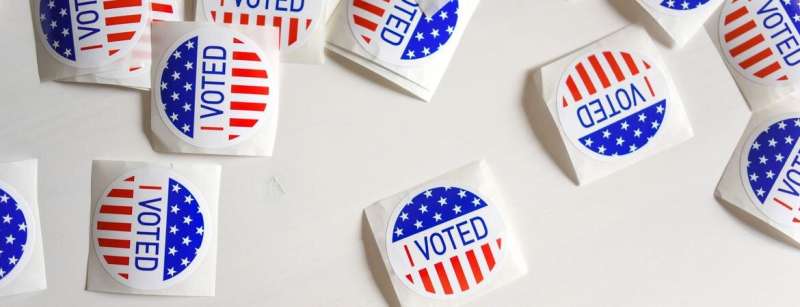Credit: Element5 Digital via Unsplash
Nearly three years later, it's rare to read a postmortem of the 2016 presidential election that doesn't include at least a passing mention of one of the electorate's more elusive unicorns: the Obama-to-Trump voter.
It's estimated that around 9% of voters who supported Barack Obama in 2012 crossed party lines to endorse Donald Trump in 2016—but why? According to a team of researchers that included Loren Collingwood, an associate professor of political science at the University of California, Riverside, the reasons behind so-called "vote switching" might be more complicated than originally expected.
Along with UCLA's Tyler Reny and Princeton University's Ali Valenzuela, Collingwood examined a set of untested hypotheses proposed as explanations for Trump's success in recruiting previous supporters of Obama, in particular.
The researchers first focused their analysis on whether a sizable number of white voters had switched from Obama to Trump in 2016, and if those same voters mainly identified as working class. They also evaluated whether concerns related to race and immigration or economic anxiety were more likely to be associated with vote switching in 2016.
They found that among white voters, a nontrivial number of those who identified as working class, as well as a nontrivial amount of those who didn't, switched their votes in 2016. Moreover, among both classes of white voters, switching was more likely to be associated with attitudes toward race and immigration than economic factors. Their findings were published in the journal Public Opinion Quarterly.
"This paper is the first to thoroughly examine the correlates of vote switching in the 2016 election," Collingwood's team wrote. "Our findings suggest that the United States may be in the midst of further electoral realignment as partisan voting continues to polarize around issues of race and immigration."
The researchers suggested that over the past decade, a handful of elements—including rapid Latino population growth and the two-term presidency of the nation's first black president—further contributed to partisan polarization around issues of race and immigration.
Likewise, as the Republican Party became known as the party of wealthy elites, the Democratic Party grew increasingly reliant on minority voters. Those factors, coupled with the collapse of American manufacturing, left white, working-class voters feeling alienated from both parties—and essentially created a void for a candidate like Trump to fill.
To learn more about those voters, the researchers reviewed data from a survey sample of more than 64,000 people representative of the U.S. adult population.
They discovered that although most of the respondents included remained loyal to the same party in 2012 and 2016, about 6% of white working-class voters and 2.4% of white non-working-class voters switched to Trump in 2016. In contrast, only 2% of white working-class voters and 3.1% of white non-working-class voters switched from supporting Mitt Romney in 2012 to Hillary Clinton in 2016.
"Given that there were over 50.5 million white non-working-class voters and over 46.4 million working-class white voters in 2016, these percentages are not trivial and suggest that, in raw numbers, many more working-class whites than non-working-class whites switched their votes in 2016 from Obama to Trump and far fewer from Romney to Clinton," the researchers wrote.
From there, the team sought to better understand the rationale behind the switches. They weighed voters' responses to two batteries of questions: one related to acknowledgement of race and racism, and another that gauged support for a range of immigration policy proposals.
The researchers then compared voters' levels of "economic marginality" by measuring self-reported family income relative to each respondent's surrounding economic environment.
Their results illuminated some of vote switching's more ambiguous aspects. First, they observed that pronounced attitudes toward race and immigration were defining attributes of voters who switched in either direction. Moreover, both working-class and non-working-class whites were more likely to switch to Trump if they demonstrated strong racially conservative or punitive immigration views, regardless of economic status.
"White voters who held punitive immigration or racially conservative views were more likely to switch to Trump in the 2016 election than those with pro-immigration or racially liberal views, who were more likely to switch to Clinton," the researchers wrote.
"While more working-class whites switched to Trump and more non-working-class whites to Clinton, the associations between their symbolic racial and immigration attitudes and vote switching were not substantively different," they added. "We find little evidence that economic dislocation and marginality were significantly related to vote switching in 2016."
The researchers noted that while their findings might tell a different story than established media narratives, such results could be indicative of an era of partisan realignment. White voters, including vote switchers, may be sorting into new parties primarily based on their stances toward issues of race and immigration. And, as communities continue to diversify, it's possible both parties will become even more polarized around such issues.
More information: Tyler T Reny et al, Vote Switching in the 2016 Election: How Racial and Immigration Attitudes, Not Economics, Explain Shifts in White Voting, Public Opinion Quarterly (2019). DOI: 10.1093/poq/nfz011
Provided by University of California - Riverside





















